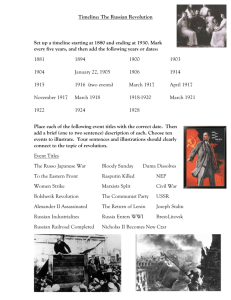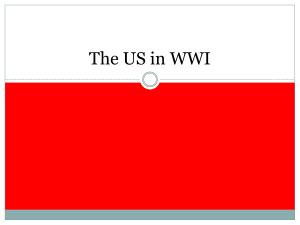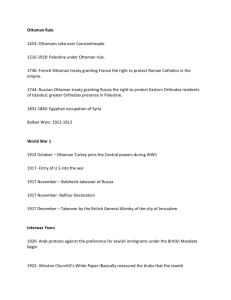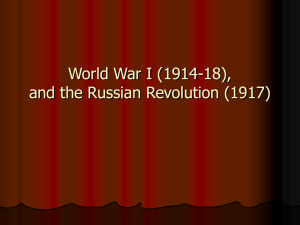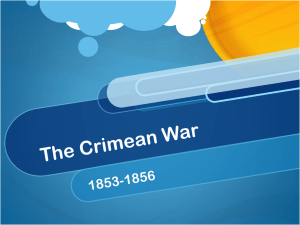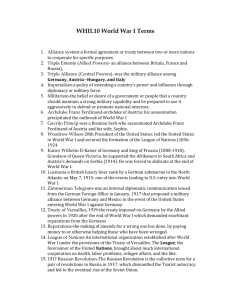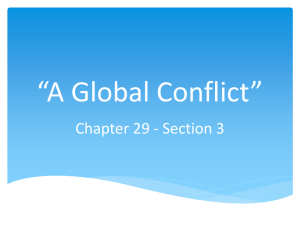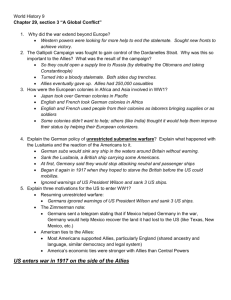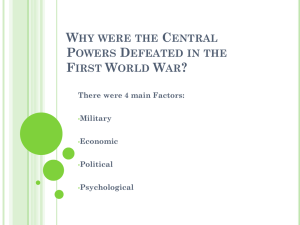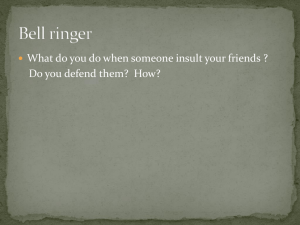Chpt 28 PPt
advertisement
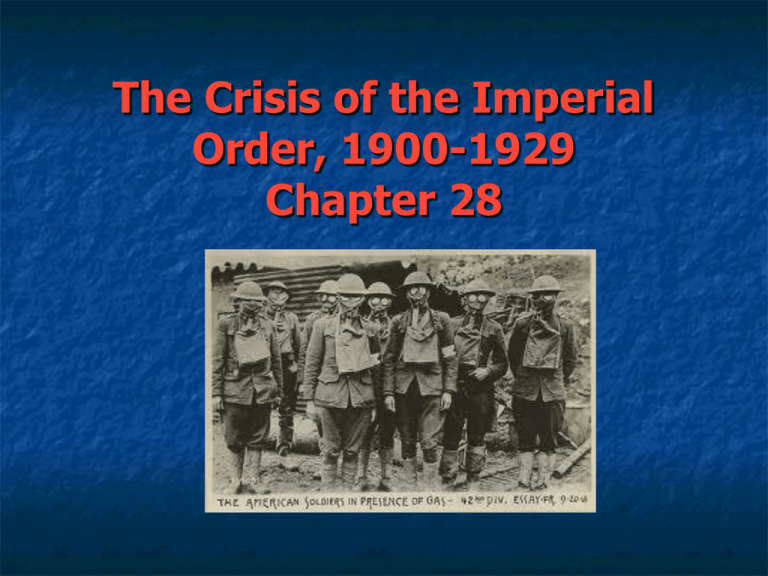
The Crisis of the Imperial Order, 1900-1929 Chapter 28 Origins of the Crisis in Europe and the Middle East The Ottoman Empire and the Balkans By the late 19th century the Ottomans were on the decline Young Turks and Germany Nationalism, Alliances, and Military Strategy Causes of WW1 Nationalism Undermined large multiethnic empires Crusade for liberty Revenge for past injustices Heal class divisions Alliance system Militarism Germany’s ambition Austria-Hungary declared war on Serbia in 1914 Assassination of Archduke Franz Ferdinand Two Alliances Triple Alliance Triple Entente The “Great War” and the Russian Revolutions, 1914-1918 Stalemate, 1914-1918 Western Front Unbroken line of trenches For __ years the war was inconclusive The Home Front and the War Economy Demands for trench warfare Stringent controls (rationing) Recruitment of: British naval blockade Africa British and French overran German colonies Used for crops, labor, and soldiers The U.S. capitalized on the war. How? The Ottoman Empire at War Allies with Germany in 1914 Unsuccessful against Russia Deport of Armenians Closed Dardanelles Straits British subversion Hussein ibn Ali of Mecca Balfour Declaration of 1917 “establishment of Jewish national homeland in Palestine” Britain troops in Mesopotamia Double Revolution in Russia, 1917 Russian incompetent by 1916 Czar (tsar) overthrown in 1917 Vladimir Lenin’s “Bolshevik Revolution” The End of the War in Western Europe, 1917-1918 German resumption of unrestricted submarine warfare brought the U.S. into war in April 1917. Zimmerman Letter The arrival of U.S. allowed Allies to counterattack against Germany. Armistice signed on November 11th, 1918. Peace and Dislocation in Europe, 1919-1929 The Impact of the War Effects Physical destruction Refugees Immigrants to: Closed door policy Influenza epidemic 1918-1919 Killed over __ million people Hastened mines, railroad, and factory production The Peace Treaties Paris Peace Conference David Lloyd George Woodrow Wilson Georges Clemenceau Treaty of Versailles Humiliated Germany War guilt clause Reparations Demilitarization Austro-Hungarian Empire fell New countries created from: Russian Civil War and the New Economic Policy Russian Civil War Continued 3 more years By 1921, Communists defeated their political enemies By 1922, the Soviet republic of Ukraine and Russia merged to create ________. Soviet Union built a modern socialist industrial economy by extracting resources from the peasants in order to pay for industrialization. Lenin dies in 1924, _____ succeeds. An Ephemeral Peace The decade after the end of the war can be divided into two periods: five years of painful recovery and readjustment (19191923) followed by six years of growing peace and prosperity (1924-1929). Germany French occupation inflation China and Japan: Contrasting Destinies Social and Economic Change China Rapid population, unfavorable land, heavy taxation, and flooding Social tension Japan Non-arable land, natural resources, natural disasters Industrialization Search and Results economic growth caused social tension between zaibatsu and poor farmers Prosperity depended on ____ and ____. Page 13 Revolution and War, 1900-1918 China Boxer Affair in 1900 led to desire of overthrow of Qing and modernization of country. Sun Yat-sen elected president but presidency turned over to general Yuan Shikai Japan Joined ____ in WW1 Benefit from: Conquered German colonies in China Twenty One Demands Chinese Warlords and the Guomindang, 1919-1929 Paris Peace Conference Allowed Japan to retain China Protests in Beijing 1919 Chinese warlords Supported army through plunder and arbitrary taxation Result: In the 1920s China reorganized forming the Chinese Communist Party and industrial modernization. However, corruption and incompetent administration kept China poor. The New Middle East The Mandate System German and Ottoman were given as colonies to the Allies. German was Class B Ottoman was Class A Britain- Palestine, Iraq, and Trans-Jordan France- Syria and Lebanon The Rise of Modern Turkey Mustafa Kemal formed a nationalist government in 1919 and reconquered Anatolia and area around Constantinople from W. Europe. Modernization Secular Alphabet Family Women Dress resistance Arab Lands and the Question of Palestine Changes in Middle East Nomads Population grew 50% Westernization Maghrib (Algeria, Tunisia, and Morocco) France monopolized government jobs and businesses Arabs and Berbers remained poor and suffered from discrimination England declared Iraq and Egypt independent in 1922 Limit wave of Jewish immigration in Palestine that began in 1920 Society, Culture, and Technology in the Industrialized World Class and Gender Class Declined and displays of wealth came to be regarded as _____. Increase in white collar work Decline in blue collar. Why? Women Suffrage 1915-1934 No effect on politics. Why? Revolution in the Sciences Discover of sub-atomic particles, quanta, Einstein’s theory of relativity undermined _____’s physics and offered new opportunity for: Innovation in social sciences challenged traditional values. Sigmund Freud Emile Durkheim The New Technologies of Modernity Airplanes Radio Film in 1920s U.S., Japan, India, Turkey, Egypt Diffusion on American culture Health and hygiene Medicine, sewage treatment, pluming, soap Result: Technology and the Environment Skyscrapers Automobiles Replaced horses Suburbs Damns and canals Generate electricity
